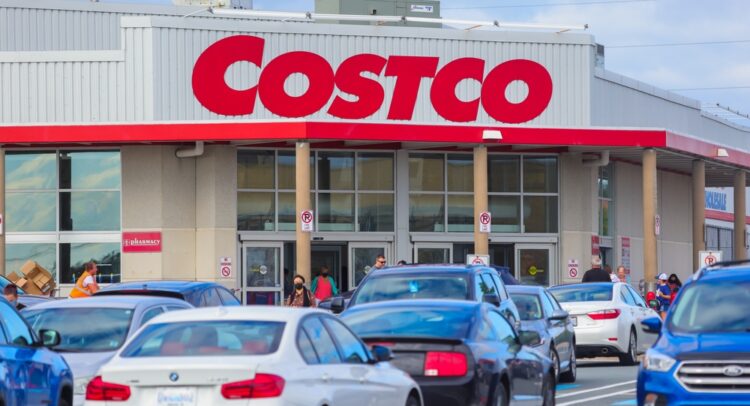Costco (COST) is a membership-only retailer with most locations in the United States. The company’s share price has risen far faster than its earnings as investors continue to buy “great businesses” at any price (in this case, 56x earnings). However, two concerning trends are emerging: weight-loss drugs and health-conscious consumers. Both factors cloud the growth story for Costco and its bulk buying philosophy. Meanwhile, the U.S. consumer is weakening after a decade of spending spree. All things considered, I’m bearish on COST stock.
Why Costco’s Outperformance Likely Won’t Last
Costco is a membership-based warehouse club offering a wide range of products at discounted prices.
To understand Costco’s meteoric stock performance over the past decade and why I don’t think it could last, we need to look under the surface. Sure, the company’s earnings have grown modestly. But, this was partially driven by an expansion of profit margins in a U.S. economy that was running hot. Also, Costco’s P/E ratio expanded from 25x earnings in 2014 to 56x earnings today! This is a dangerous and often unsustainable way to increase a company’s stock price.
These days, with unemployment rising in the United States, Costco’s profit margins and P/E ratio could simultaneously take a hit, sending its shares tumbling.
Peak Profit Margins Hit a Wall
Over the past decade, Costco’s profit margins expanded from 1.9% to roughly 2.9%. This number may sound low, but it is quite high for a retailer that sells a lot of groceries and gasoline. Costco’s profit margins peaked in early 2024 and have been declining since. This is amid news that the U.S. consumer power is weakening, with Moody’s reporting that “easing wage growth, dwindling savings and high borrowing costs are straining consumers.”
As a consequence, I do not expect a retailer like Costco to benefit during times of economic weakness. This is because the company sells many durable, discretionary items like kayaks, TVs, gold, tools, etc. Also, Costco’s consumers are often big spenders who have benefited from the boom in the U.S. economy, including the rise in the stock and housing markets.
Investopedia profiled the average U.S. Costco customer as “a 39-year-old college-educated Asian-American woman who earns more than $125,000 annually.” When your customer has many assets and a high wage, they may be disproportionately affected by a change in economic fortunes. They may also choose to cancel their membership or trade down to a retailer that offers smaller quantities of goods rather than large, bulky ones during the recession.
Times Are Changing
My bearish sentiment continues when I examine the current climate regarding health awareness. As mentioned in the beginning, this trend is concerning for Costco. Younger generations and international populations are becoming increasingly informed and health-conscious. I don’t see this benefiting a retailer like Costco that sells enormous bulk quantities, promotes over-consumption, and places little focus on nutrition (with its cafeteria hot dogs, ice cream, and pizza as a prime example). Also, weight loss drugs will begin to curb a lot of the overconsumption that Costco benefits from.
All this may seem like a small problem, but one doesn’t need to look much further than Kraft Heinz’s (KHC) performance to understand how changing health trends can affect a stock’s performance. Many people who built Costco were quite elderly (Charlie Munger, Craig Jelinek, etc) and may have underestimated these emerging trends. Even Costco’s discounted gasoline doesn’t paint the most environmentally friendly picture amid the hybrid and electric vehicle trend.
Newer Options
In Canada, companies such as Loblaw Companies (L) are eating Costco’s lunch and seem to lure the next generation of consumers. A lot of young people seem to be shopping at Loblaw’s Superstore and No Frills grocery stores, and the company is employing intelligent “Simple Check” marketing, displaying a check mark on its in-house brand that tells consumers that the food is free of artificial flavors, synthetic colors, and MSG, among other unhealthy additives. Not to mention, I find shopping at Loblaw stores to be much cheaper than shopping at Costco.
I’ve heard that similar trends are emerging in Europe and other continents. If these trends spill over into the United States, it could hinder Costco’s international expansion and hurt its domestic business. Weight loss drugs like Ozempic are already in the U.S., further muddling the company’s growth story.
Is COST Stock a Buy, According to Analysts?
Currently, 18 out of 21 analysts covering COST give it a Buy rating, three rate it a Hold, and zero analysts rate it a Sell, resulting in a Strong Buy consensus rating. The average COST stock price target is $931.05, implying upside potential of 4.38%. Analyst price targets range from a low of $800 per share to a high of $1061 per share.

While Costco analysts remain unrelentingly bullish, I think they are missing some of the emerging trends discussed in this article. This could disproportionately affect a stock like Costco at a bubbly valuation of 56x earnings. I have Costco stock facing a lost decade (zero returns over ten years), and think it could fall 40% just to reach fair value.
The Bottom Line on COST Stock
Costco stock has a bubbly valuation when you consider that it’s moving in the opposite direction of health-conscious consumers. People seem to think Costco is defensive, but its margins were far lower a decade ago when the U.S. economy wasn’t quite as hot. With unemployment rising, this could be about to change. If Costco’s P/E multiple contracts and its margins stagnate or decline, the stock could drop significantly and face a lost decade. Therefore, I am bearish on COST stock.
















